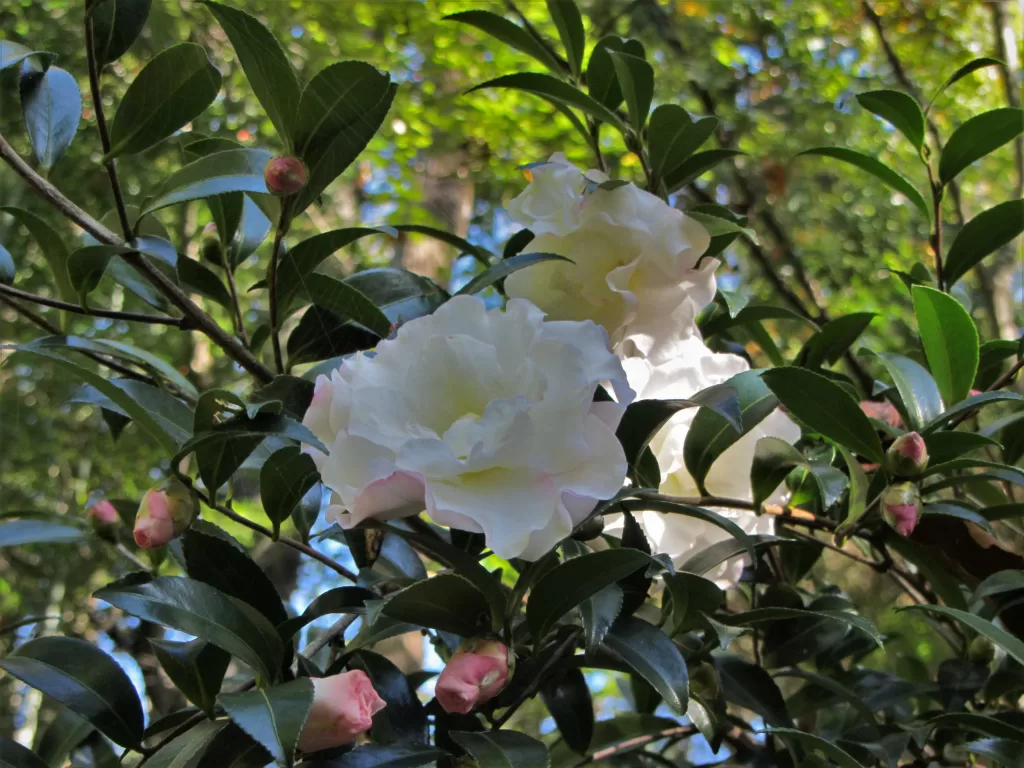How to Create a Haven for Hummingbirds
A friend showed me a video she had taken in her backyard of hummingbirds swarming around one of her feeders. She loves hummingbirds and works hard to attract and care for them. She plants containers filled with flowers she knows they like, and maintains multiple feeders kept stocked with sugar water. She told me that she has several tiny feeders on stakes that she places among the flowers in her containers.
There were so many tiny birds flying about in her video, we couldn’t even count them. She just beamed as we enjoyed watching the birds she loves caring for each day. She told us that several dozen hummingbirds visit her yard to feed each summer day.
Magic and Awe
Hummingbirds delight us with their beautiful, iridescent colors, distinctive sound, and their aerial acrobatics. They fly so fast that we can barely follow them to see where they will next feed or alight. Often grouped in with the insect pollinators, hummingbirds are tiny, warm-blooded birds with their own unique behaviors and needs. They are intelligent and observant, affectionate, and quick to respond. Patient gardeners have even hand-trained hummingbirds who live in their yards. As tiny as fairies, their very presence in the garden brings a sense of magic and awe.
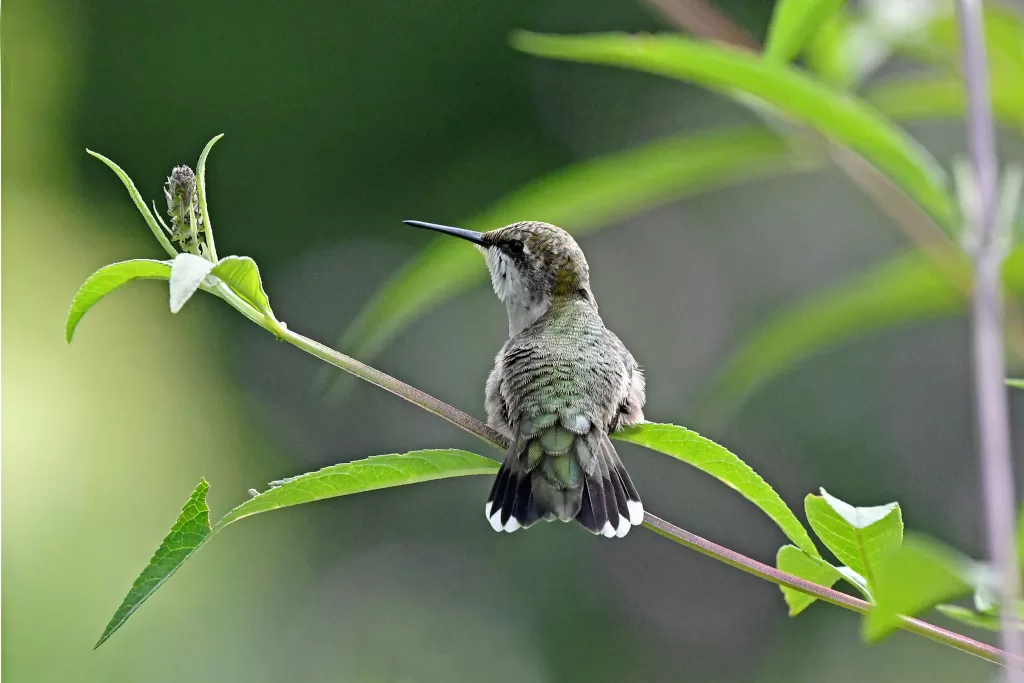
Female Ruby-throated Hummingbird at rest on Buddleia davidii at the WBG-FPA. Photo by Jim Easton July 2021
One summer night I arrived home just past dusk to the mysterious sight of tiny, luminous beings flying among a stand of white butterfly ginger lilies. For a moment I wondered whether perhaps a small family of fairies was living in our garden. The flying bodies of these creatures glowed white in my headlights. Cautiously, I stepped out of the car and took a few steps closer to investigate. As I drew closer, I heard the distinctive hum of hummingbirds and saw that these apparent ‘fairies’ were a family of tiny birds feeding from the ginger lily flowers. Their feathers glow with bioluminescence in the dark.
New World Birds
Hummingbirds are all native to the Western Hemisphere, and most species live in Central and South America. There are a few main species of hummingbirds that visit our area each year, and a few more species are occasionally spotted in Virginia. Like most butterfly species, and many other species of birds, hummingbirds migrate each spring and fall, spending their winters in tropical areas.
We can count on hosting the Ruby-throated Hummingbird, Archilochus colubris, each summer. It is one of the only hummingbird species which breeds east of the Mississippi River. It overwinters in Mexico and Central America. This is the most common hummingbird species spotted in the Williamsburg area. Males begin to arrive in April, followed by females, who continue arriving through mid-May. Some birds will remain in familiar habitats to breed while others will continue to areas to our north.
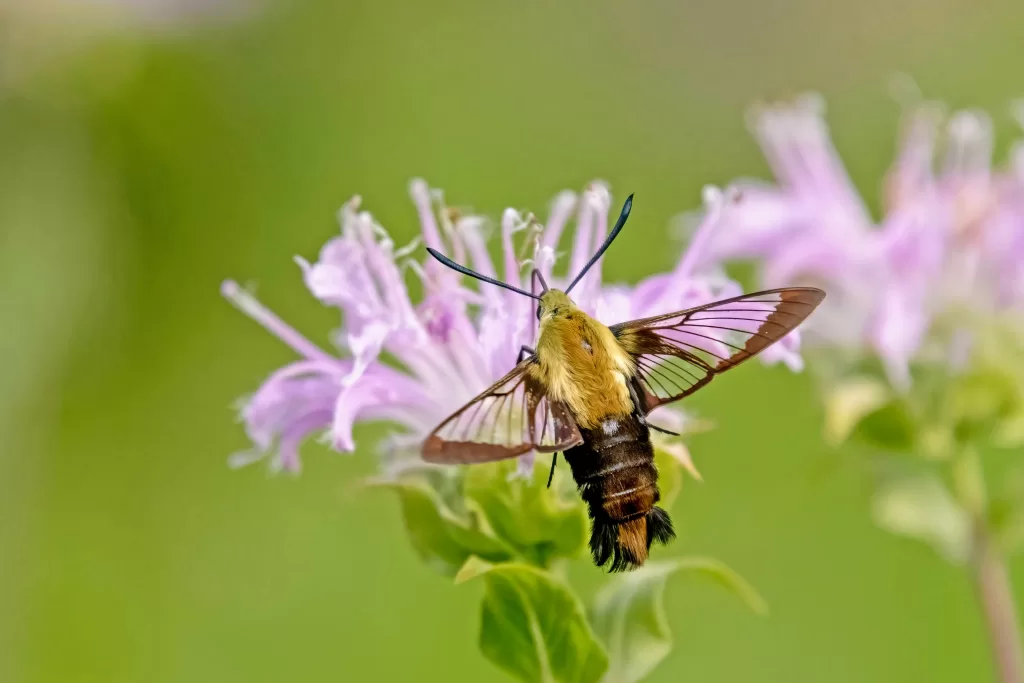
A hummingbird moth feeds on Monarda fistulosa while hovering, their wings beating rapidly like a hummingbird’s wings. Don’t let this beautiful insect confuse you. Notice the very moth-like antennae and flexible proboscis. Photo by Jim Easton at the WBG-FPA July 2023.
Other species occasionally spotted include the Rufous Hummingbird, Selasphorus rufus, which breeds from Alaska to Northern California along the West Coast. These may be spotted in late fall and very early spring. It is known as a small and aggressive hummingbird that has a black beak. It overwinters from the Baja Peninsula through Northern Mexico and the Gulf States east to Florida and may be sighted in the Southeast as far north as New England. Recent ‘accidental visitors’ to our area of Virginia include Black-chinned Hummingbirds and Allen’s Hummingbirds.

Female Ruby-throated Hummingbird Photo by Jim Easton at the Williamsburg Botanical Garden August 2019
Making a Summer Home for Hummingbirds
It is possible to bring home the magic of hummingbirds to our own gardens by understanding and providing for their needs. All wildlife need sources of food and water, safe habitat for nesting and for resting, and an environment free from toxins. Hummingbirds have specific needs because of their tiny stature. Most weigh little more than a coin and need to eat at least half of their weight daily to produce the energy they need to fly.
Hummingbirds build their nests on branches of dense shrubs or trees in places humans will rarely notice them. Nests may be as tiny as half of a chicken’s egg or ping-pong ball, made from moss, lichens, and other small fibers and plant materials held together with the strong, sticky filaments of a spider’s web. They frequently choose large shrubs along the tree line where they have shelter from the weather, a clear line of sight, and easy access to food sources.
A Place to Rest
Although we may rarely notice hummingbirds at rest, they frequently perch on stems and twigs and various lines and wires where they can watch for insects. If you have a string of fairy lights on your deck or patio, you may find hummingbirds perching on the wires. Some gardeners hang small, decorative perches for hummingbirds. They will rest on vines and small twigs. They prefer to perch in open areas where they can quickly take off again to rejoin the hunt for food. Residential yards and city parks are excellent habitats for hummingbirds.
Offering Water
Have you ever watched a hummingbird fly through a sprinkler? Or have you ever had one stop to play in the spray as you water your garden? Hummingbirds love fine spray. All birds need a source of fresh, clean water. Adding a very shallow pan of water, or a shallow birdbath with a bubbler, fountain or mister instantly makes your yard more attractive to hummingbirds and other bird species. If you add rocks and small pebbles to a shallow pan of water, butterflies, dragonflies, and other small animals can also stop to drink. Hummingbirds may try to hover over water to bathe if it is too deep for them to land, but a well-placed rock makes things easier for them.

A male Ruby-throated Hummingbird feeds from Monarda didyma. Photo by Jim Easton at the WBG-FPA June 2021
Providing Plentiful Food
While we may think of hummingbirds as pollinators who seek out nectar, about one-third of a hummingbird’s daily diet includes insects and spiders. Hummingbirds can help control the flying insects in one’s yard because they need to eat so many mosquitoes, flies, gnats, aphids, and other pests each day. You may see them ‘poach’ insects out of a spiderweb. Hummingbirds look for webs to harvest strands of silk for their nest, and they will help themselves to any insect or small spider that they can easily eat.
You have probably heard that hummingbirds are attracted to red when searching for food. Commercial hummingbird feeders often have red feeding tubes. While hummingbirds will take nectar from almost any red flower, they will also drink from flowers of other colors. They prefer a tubular flower that allows them to stick their beak, and to extend their long, flexible tongue into the neck of the flower to seek nectar. I’ve seen them visit white, purple, pink, yellow, orange, and blue flowers, as well as red ones. While it is easy for them to find nectar in large blossoms, they can find nectar in tiny flowers, like those on a basil or mint plant, too.

A male Ruby-throated Hummingbird rests on native coral honeysuckle at the WBG-FPA. Photo by Jim Easton June 2023.
Offering Hummingbird Feeders
Gardeners who are most successful in hosting families of hummingbirds often offer both sugar water and a variety of flowers. Drinking sugar water from a feeder helps birds recover from their spring migration. They will seek it out again to prepare for their flights in the fall. Well-placed, obvious feeders may draw hummingbirds to your yard or balcony in early spring. Natural nectar is more nutritious, however, and insects provide protein and other nutrients. It is important to have several nectar feeders, preferably 15’ or more apart, and high enough off of the ground that birds won’t be threatened by cats or snakes as they feed. Also, keep the nectar feeders 15’ or more away from traditional bird feeders. Hummingbirds can be very aggressive and territorial about their feeders and may fight off other birds who try to use them.
Sugar Water Nectar Recipe
Keep feeders very clean, washing them every few days when you re-fill them. The healthiest nectar is made from one part refined white sugar and four parts of water. Using honey, raw, or brown sugar is not advised because substances in them may hurt the hummingbirds. You can make a small batch to fill a small feeder with 2 TB of sugar to 4 TB of water. Shake the mixture in a clean jar until the sugar dissolves. There is no need to boil it when the water is clean. Don’t add any food coloring as it isn’t necessary, and the dye doesn’t do anything helpful for the birds. This mixture will keep for a week or two, covered in the fridge, if you make a larger batch.
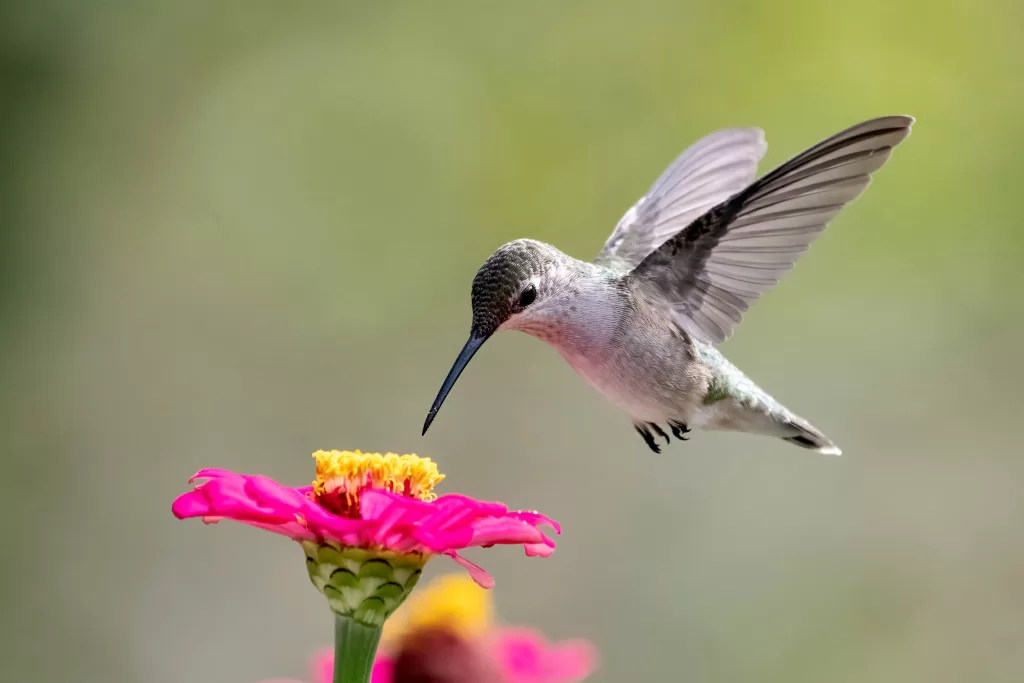
Female Ruby-throated Hummingbird considers a Zinnia at the WBG-FPA. Photo by Jim Easton September 2022.
Flowers for Hummingbirds
The great joy of gardening for hummingbirds comes from watching them feed from the flowers in your yard. I love watching hummingbirds feed on the rose of Sharon flowers growing near my kitchen window. Some mornings, I find a small family of them flitting from container to container, drinking from flowers on my front patio. They love the hanging baskets of Verbena hanging on our deck.
Flowers growing near the house in containers bring the birds in close enough to observe without disturbing them. Anyone who has even a porch or a balcony can attract hummingbirds by offering a combination of container-grown plants and a hanging feeder.
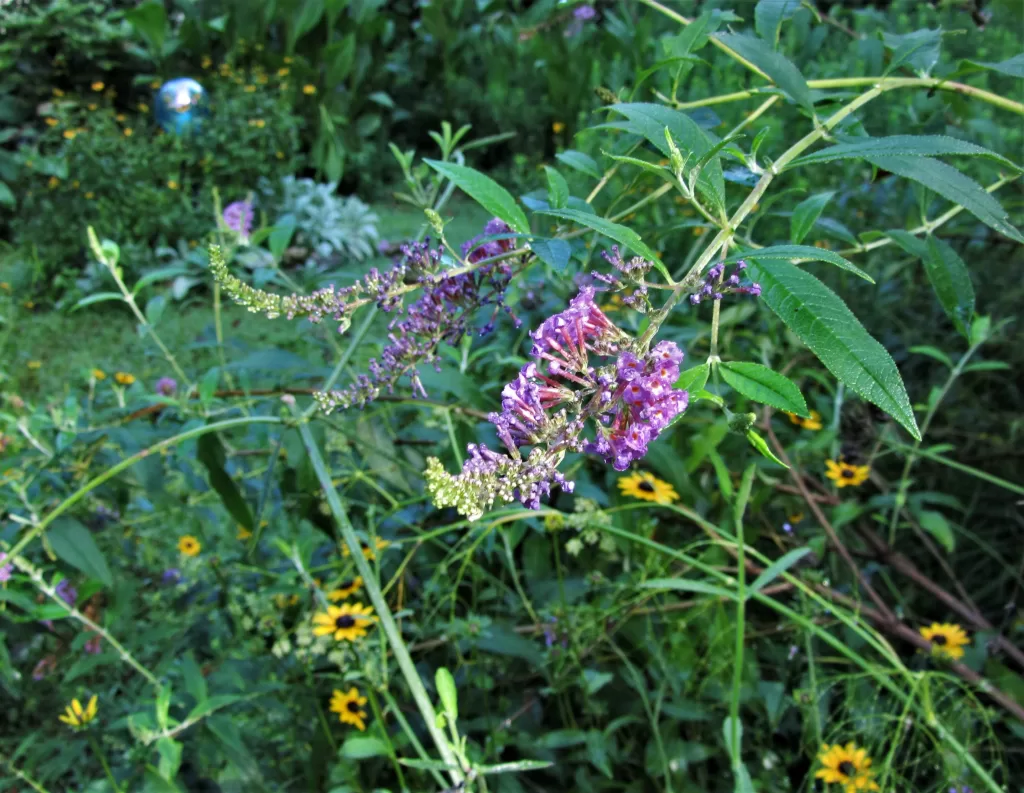
Butterfly bush provides abundant nectar almost until frost. Hummingbirds can rest on its thin stems to survey the garden for any lurking danger. Photo by Elizabeth McCoy September 2021.
A Plant List for Your Hummingbird Garden
Following is a short list of flowers that hummingbirds especially love. It is sorted by the type of plant and by season. It is possible to feed resident and visiting hummingbirds from early spring through late autumn by cultivating a variety of flowering plants that attract them. Cultivating plants that support a variety of small insects makes your yard even more attractive to hummingbirds looking for a home to raise their young.
Trees and Shrubs
Trees and shrubs provide the structure of a good hummingbird garden. Trees that attract insects for hummingbirds to eat are as useful as flowering shrubs with attractive flowers. Trees with thin, downward-sloping branches are preferred for nesting.
Hummingbirds need trees and large shrubs that grow beside open, sunnier spaces. Females will sit on branches watching male hummingbirds perform aerobatics in nearby open areas during mating season. Plant nectar-rich flowers 10’-15’ away from trees, in an open area where the birds will feel safe. These nearby trees also provide cooling shade on hot days.
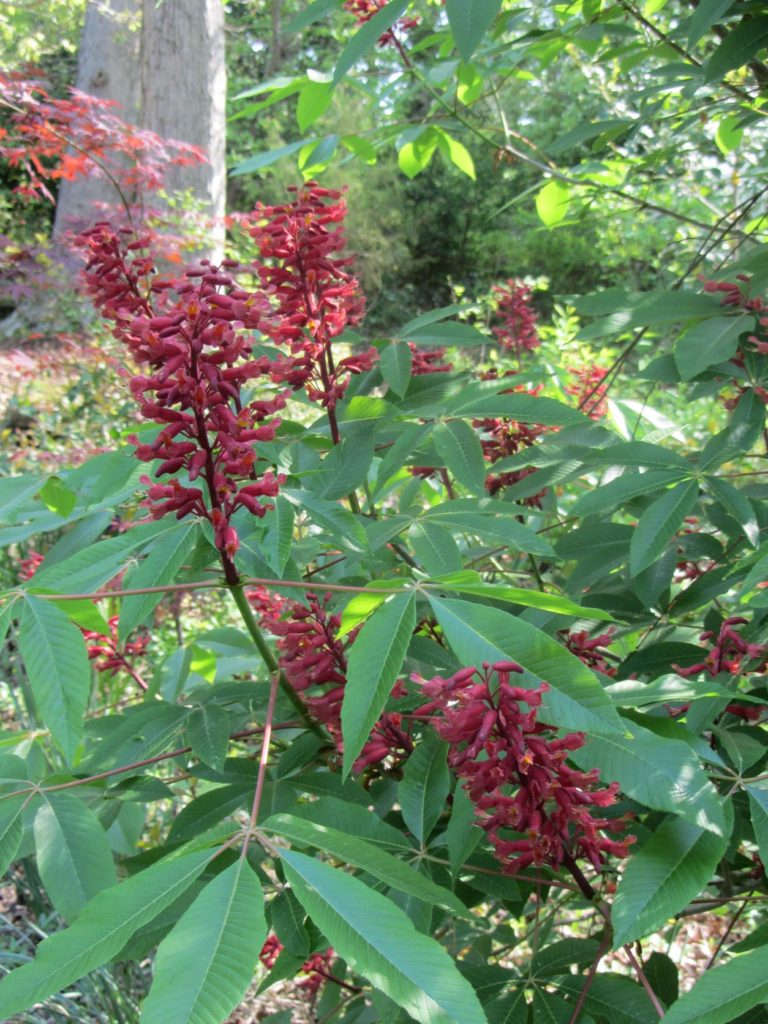
Scarlet Buckeye blooms in April, attracting hummingbirds and other pollinators. Photo by Elizabeth McCoy
Spring
Aesculus pavia, scarlet buckeye
Cercis canadensis, redbud
Liriodendron, tulipifera, tulip tree
Magnolia species and hybrids that bloom in early spring
Rhododendron ssp., including native and hybrid Azaleas. While the Azaleas don’t have the best nectar for hummingbirds, they provide cover and will attract a wide variety of insects for them to catch.

Rose of Sharon flowers entice hummingbirds, and many types of insects, over a long season each summer. Photo by Elizabeth McCoy August 2023.
Summer
Abelia spp. This common shrub has tubular flowers that hummingbirds favor and also attracts many pollinating insects for them to catch.
Albizzia julibrissin, Mimosa tree, with fuzzy ‘powder puff’ flowers, has made it to many invasive species lists. It is an Asian tree that needs little care, naturalizes easily in Virginia, and is a rich source of nectar for hummingbirds and insects.
Cephalanthus occidentalis, Buttonbush is an indigenous native shrub.
Hibiscus syriacus, rose of Sharon, produces flowers like native H. moscheutos, over many months. It attracts a wide variety of pollinating insects and hummingbirds are drawn to this rich source of nectar.
Weigela spp.
Fall/Winter
Camellia spp.
Daphne spp.
Pieris japonica
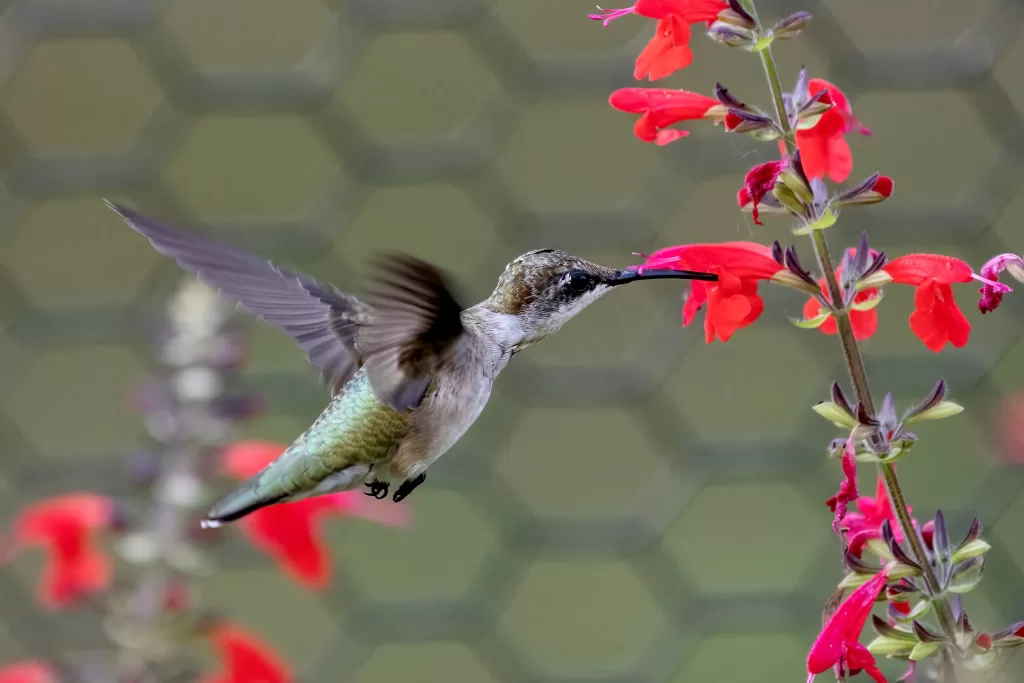
A female Ruby-throated hummingbird feeds on Salvia coccinea, a Gulf Coast native, at the WBG-FPA. Photo by Jim Easton August 2022.
Annuals and Perennials
Herbaceous annuals and perennials provide color and beauty to our gardens. They are fun to grow, and they have the added benefit of supporting a variety of pollinators. Choices abound as we select our favorite colors, sizes, and forms. In general, hummingbirds will prefer to feed several feet off of the ground for their own safety. They appreciate nectar-rich flowers in hanging baskets and tall perennials whose flowers are held several feet above the ground, like the stately Verbena bonariensis and Canna lilies. Many of these plants produce flowers over a long season and will attract many insects that are an important part of the hummingbird diet.
Spring
Aquilegia spp., columbine
Heuchera spp., coral bells
Hyacinthoides hispanica, Spanish bluebells

A female Ruby-throated Hummingbird feeds on Salvia ‘Black and Blue’ at the WBG-FPA. Photo by Jim Easton July 2022.
Summer
Agastache spp., hummingbird mint
Alcea rosea, hollyhocks
Begonia spp.
Calibrachoa hybrids
Canna spp.
Cleome hassleriana, spider flowers
Coleus spp.
Crocosmia cultivars
Gladiolus spp.
Hibiscus spp.
Kniphofia uvaria, red hot poker

A Ruby-throated Hummingbird feeds on Lantana camara at the Williamsburg Botanical Garden. Photo by Jim Easton August 2019.
Lantana spp.
Lobelia spp.
Monarda spp., bee balm
Tropaeolum spp., nasturtium
Pelargonium ssp., geraniums
Penstemon spp.
Petunia hybrids
Salvia ssp., especially red flowering Salvia
Verbena spp.
Yucca filamentosa and hybrids
Zinnias
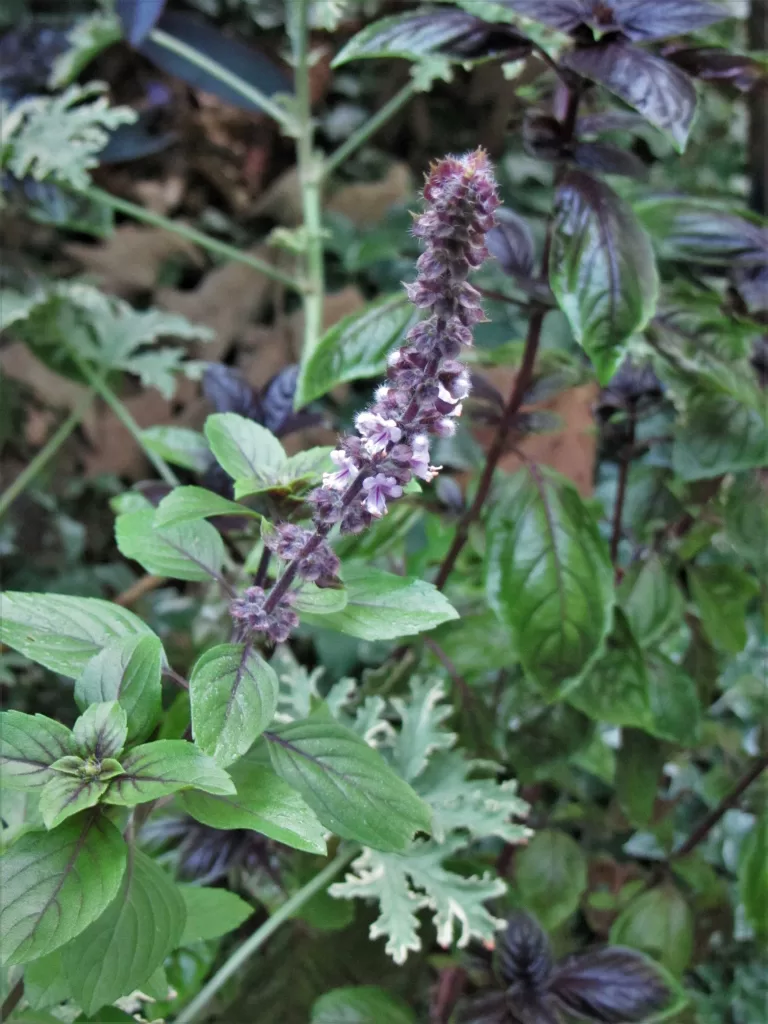
Basil and other mint-family flowers may be small, but they still attract hummingbirds. Photo by Elizabeth McCoy August 2023.
Summer Herbs
All members of the mint family, Lamiaceae, attract hummingbirds. Although their flowers may be tiny, they are tubular and filled with rich nectar. Many herb gardeners remove flower stalks as they form. Allow flowers to grow on all mints, basils, oregano, and thyme to support hummingbirds. African Blue and Thai basil have especially large, long-lasting, and productive flowers.
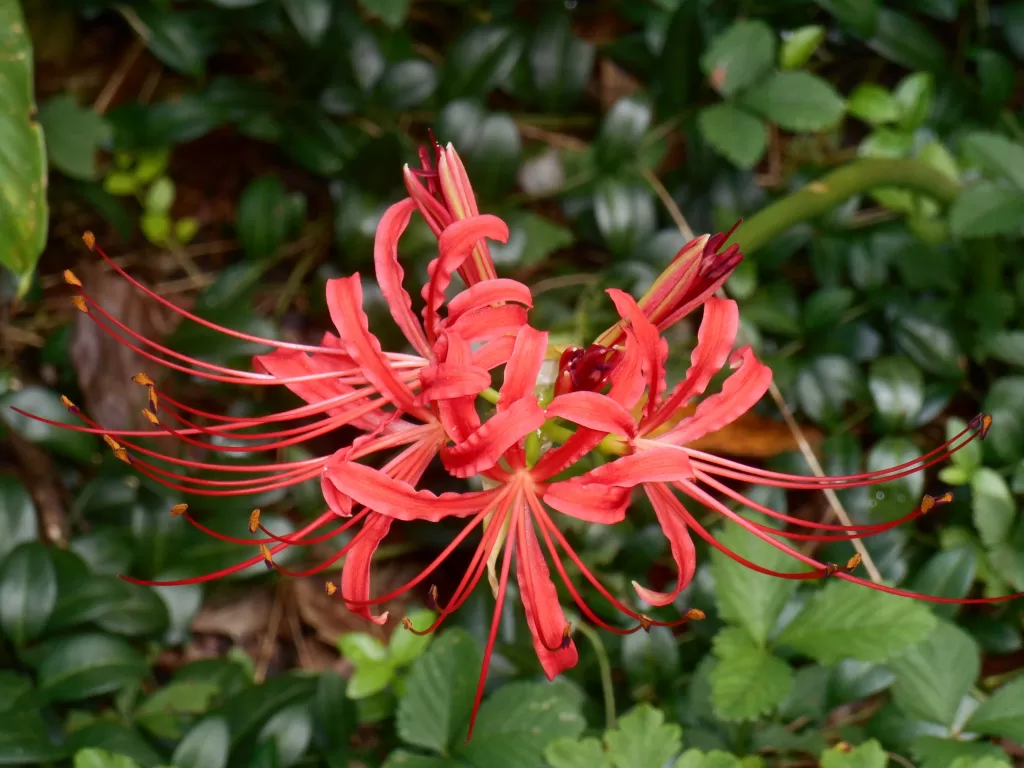
Lycoris radiata blooms in August in September, offering nectar to hummingbirds before their fall migration. Photo by Elizabeth McCoy September 2020.
Fall/Winter
Antirrhinum majus, snapdragon
Hedychium coronaria, white butterfly gingerlily
Lycoris radiata, hurricane lily
Physostegia virginiana, obedient plant
Salvia leucantha, Mexican sage
Salvia elegans, pineapple sage
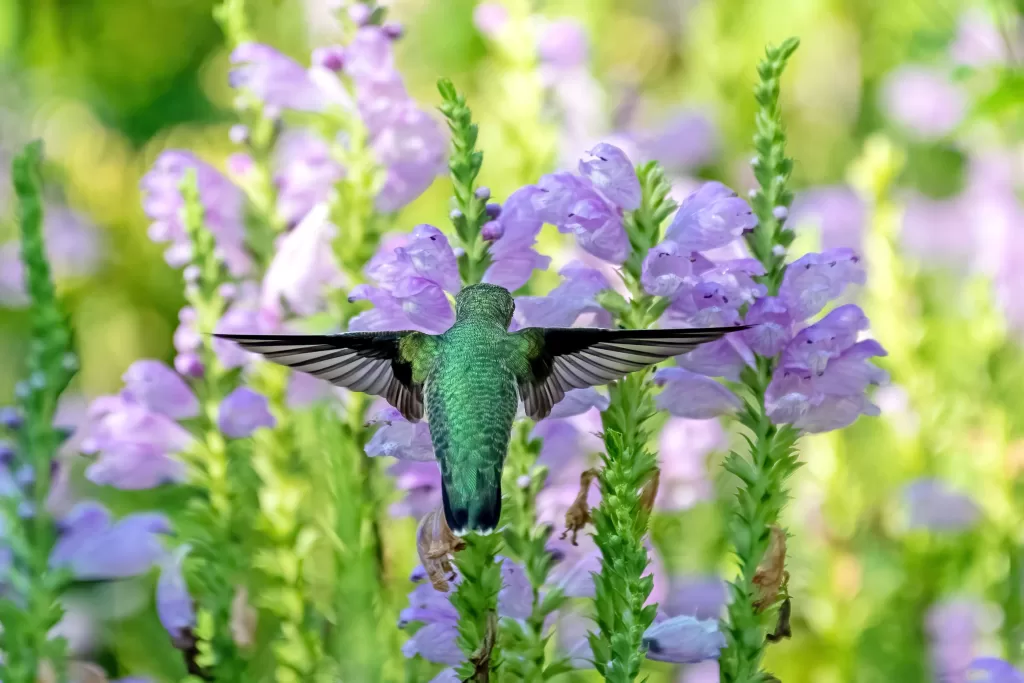
Ruby-throated Hummingbird feeds on an obedient plant at the WBG-FPA. Photo by Jim Easton August 2022.
Fall and Winter Herbs
Salvia rosmarinus cultivars, rosemary, bloom from late summer through spring on shrubby plants. They will help support any visiting hummingbirds who have strayed north from their winter habitats.
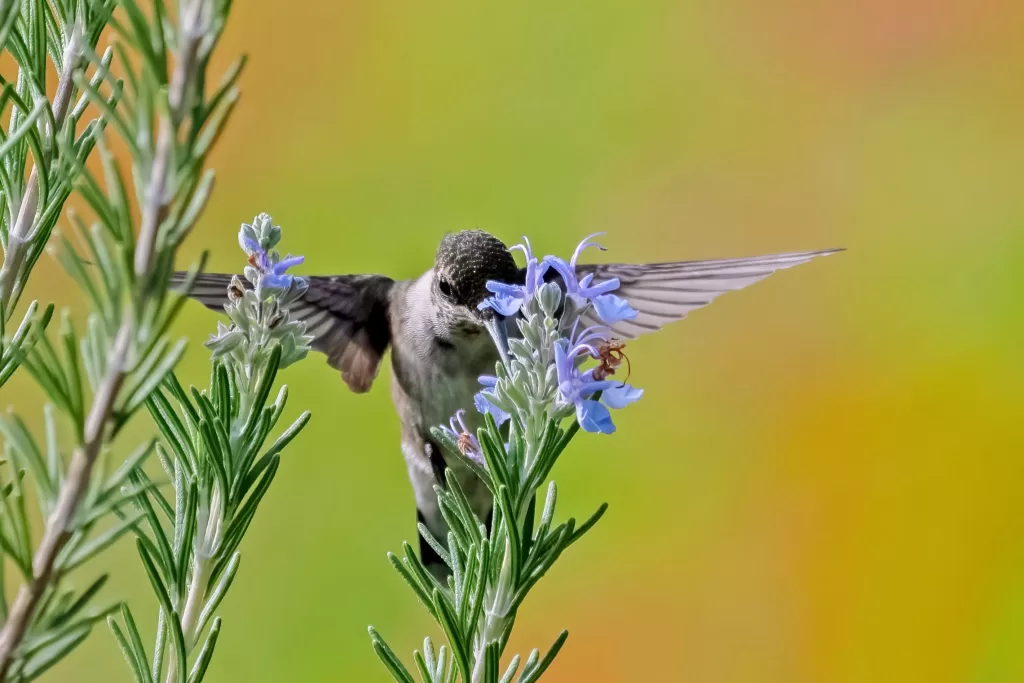
A female Ruby-throated Hummingbird feeds on rosemary at the WBG-FPA. Photo by Jim Easton September 2022.
Vines
Flowering vines offer flowers high off the ground, frequently in trees. Hummingbirds may perch on their stems to watch for passing insects, to rest, and to watch for danger.
Spring
Bignonia capreolata, cross vine
Wisteria frutescens, native Wisteria

A male Ruby-throated Hummingbird feeds on native coral honeysuckle at the Williamsburg Botanical Garden. Photo by Jim Easton June 2020.
Summer
Campis radicans, trumpet vine
Clematis spp.
Ipomoea ssp., particularly moonflowers
Lablab purpurea, Hyacinth bean
Lonicera sempervirens, Native honeysuckle
Passiflora spp., passionfruit
To Learn More
Adams, George. Birdscaping Your Garden-A Practical Guide to Backyard Birds and the Plants That Attract Them. Rodale Press. 1994.
Roth, Sally. Bird by Bird Gardening-The Ultimate Guide to Bringing in Your Favorite Birds Year After Year. Rodale Press. 2006.
Stein, Daniel.
Jim Easton is a photographer and Master Naturalist




